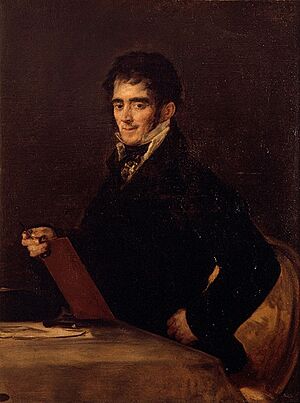Rafael Esteve facts for kids

Rafael Esteve Vilella (born July 1, 1772, in Valencia; died October 1, 1847, in Madrid) was a talented Spanish artist. He was famous for his engravings, which are a type of printmaking. He worked during the Romantic period, a time when art focused on feelings and imagination.
Contents
Rafael's Early Life and Art Training
Rafael came from a family of artists. His father, José Esteve Bonet, was a sculptor. His uncle, Agustín Esteve, was a painter. Rafael first learned art in Valencia at the Real Academia de Bellas Artes de San Carlos. Later, he moved to Madrid to continue his studies. He attended the Real Academia de Bellas Artes de San Fernando there.
During the time of King Charles IV, Rafael worked with the Royal chalcographers. These were artists who made prints from metal plates. He lived in Cádiz during the Peninsular War. After the war ended, he was able to travel. He went to France and Italy to learn even more about art.
Famous Engravings and Works
Rafael Esteve created many important engravings. Some of his most famous works include pictures for the first small edition of Don Quixote. This book was printed between 1797 and 1798.
He also made a picture called "Vista of the Teatro Seguntino, Taken from the Stands." This was for a book about Spanish architecture and old buildings. He also created portraits of important people. These included King Charles IV and King Ferdinand VII. He also made pictures of their wives and other famous figures. These portraits were for a book called Portraits of Illustrious Spaniards.
In 1839, Rafael received a great honor. He won a gold medal at an important art show in France. This was for his engraving of Moses Striking Water from a Rock. He based this work on a painting by Bartolomé Murillo. To make this engraving, he even lived in Seville for a while.
Awards and Honors
Rafael Esteve received many awards for his artistic talent. He was given a special cross in the Order of Charles III. He was also named an Honorary Director of the Academia de San Carlos. He was an "Academic of Merit" at the Academia de San Fernando. He was also a corresponding member of the Paris Academy. This meant he was connected to the art world in Paris.
Friendship With Francisco de Goya
In 1799, Rafael became the Court Engraver. This meant he made portraits of the Royal Family. He based these on drawings by his uncle, Agustín. These drawings were made after paintings by Francisco Goya. This work helped Rafael become friends with Goya.
Goya painted Rafael's portrait in 1815. This painting is not one of Goya's most famous works. However, it is very valuable. A copy of this painting was sold online for about $4 million in 2022.
Rafael Esteve and Goya stayed friends for many years. Their friendship lasted even when Goya had to leave Spain. In a letter from 1828, Goya wrote a special message. He said, "To Don Rafael Esteve a thousand things, that I often remember." This shows how much he thought of Rafael.
See also
 In Spanish: Rafael Esteve para niños
In Spanish: Rafael Esteve para niños

